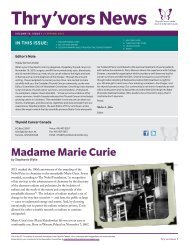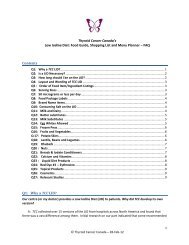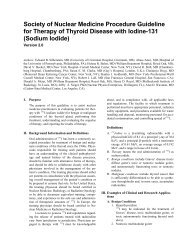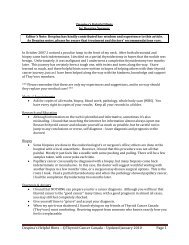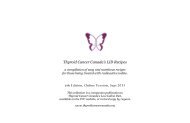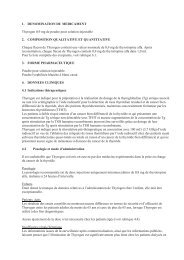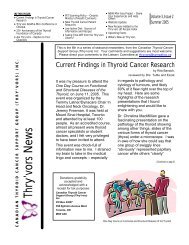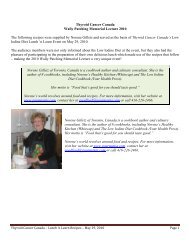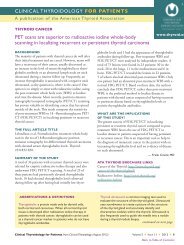Newsletter 20, Fall 2008 - Thyroid Cancer Canada
Newsletter 20, Fall 2008 - Thyroid Cancer Canada
Newsletter 20, Fall 2008 - Thyroid Cancer Canada
You also want an ePaper? Increase the reach of your titles
YUMPU automatically turns print PDFs into web optimized ePapers that Google loves.
In this issue:<br />
Is <strong>Thyroid</strong> <strong>Cancer</strong> Associated with Depression and Mood Disorders?....1<br />
Poem.......................................................................................................4<br />
Thriving Thry’vors - Featuring Lynda Murtha...........................................4<br />
Ask Thry’vors - Imaging Modalities and <strong>Thyroid</strong> <strong>Cancer</strong>................................6<br />
Article Review .............................................................................................7<br />
Upcoming Events ........................................................................................8<br />
Volume 6, Issue 3<br />
<strong>Fall</strong> <strong>20</strong>08<br />
This is the <strong>20</strong> th in a series of seasonal newsletters,<br />
from the Canadian <strong>Thyroid</strong> <strong>Cancer</strong> Support<br />
Group (Thry’vors) Inc. Your comments and<br />
suggestions are most welcome.<br />
Please direct your comments to <strong>Newsletter</strong><br />
Committee at thryvors@sympatico.ca<br />
Is <strong>Thyroid</strong> <strong>Cancer</strong> Associated with<br />
Depression and Mood Disorders?<br />
Evidence from the Literature and Patients<br />
by: Zahra Punja, PhD and<br />
Jacques Abourbih, MDCM, FRCS(C)<br />
It is not uncommon in conversations between thyroid cancer<br />
survivors to hear of their personal experience and struggle<br />
with depression, mood swings and/or anxiety prior to,<br />
during or after their diagnosis of thyroid cancer. Some<br />
survivors report having experienced symptoms of sadness,<br />
insomnia, worry, fatigue, anger, anxiety, feelings of<br />
unhappiness, episodes of panic attacks, trouble sleeping,<br />
feelings of fear, loss of appetite and feelings of despair.<br />
Recently, some Thry’vors members offered comments about<br />
their experiences through a brief survey. Chelsie from<br />
Brampton reported “For most of my adult life I have felt a<br />
generalized anxiety, and at times, even depressed. I often<br />
worried more than the next person. Once I was diagnosed<br />
with thyroid cancer, these feelings amplified.” Jane from the<br />
Philippines stated, “I would easily get irritated, cry for small<br />
issues. When my sister and I had a fight, I was really<br />
emotional and I said nasty things that I normally don’t say”.<br />
Similarly, Rochelle from Mississauga experienced the following<br />
symptoms: “I felt like I was constantly in crisis mode; any<br />
change was overwhelming; any suggested change seemed<br />
like a disaster. I felt drained of any emotion at all. I<br />
couldn’t stop crying”.<br />
For some, these feelings were temporary and existed during<br />
the first year after their thyroidectomy. For others the<br />
symptoms persisted over longer periods of time and some-<br />
Thry'vors News Seeks an Editor<br />
This newsletter needs your help. We are seeking a<br />
volunteer to help coordinate each quarterly issue,<br />
by assembling the monthly features and choosing<br />
a lead article for each. For more information call<br />
Rita Banach 416-487-8267<br />
times reoccurred, to the point that counselling and/or<br />
medications were required. In discussing these feelings<br />
with their doctors, the survey respondents said that they<br />
had not been told by their doctors that there may be an<br />
association between their thyroid cancer and their depressive<br />
symptoms. Most of our members offering comments<br />
uncovered the potential connection through their own<br />
reading and research, through internet sites and through<br />
sharing their stories within their peer network.<br />
Patients whose treatment involves a total thyroidectomy and<br />
radioactive iodine ablation may have to undergo a temporary<br />
period of hypothyroidism. As well, any time that replacement<br />
www.thryvors.org<br />
Canadian <strong>Thyroid</strong> <strong>Cancer</strong> Support Group<br />
(Thry’vors) Inc.<br />
PO Box 23007<br />
550 Eglinton Ave. West<br />
Toronto, ON M5N 3A8<br />
Phone: 416-487-8267<br />
Fax: 416-487-0601<br />
Email: thryvors@sympatico.ca<br />
Offering information and support
<strong>Fall</strong> <strong>20</strong>08<br />
THRY’VORS NEWS<br />
hormone is not at sufficient levels, patients may experience<br />
some symptoms associated with hypothyroidism. In some<br />
scientific studies, researchers experimented with withdrawal<br />
of levothyroxine medication to determine how the patients’<br />
moods were altered 1 . One study found that patients experienced<br />
increased sadness and anxiety as a result of being off<br />
their medicine 2 . Additionally, these studies showed high correlation<br />
between hypothyroidism and depression and anxiety<br />
on many relevant mood tests 3 .<br />
In a study published recently, it was found that the hypothyroid<br />
differentiated thyroid cancer (DTC) patients in the<br />
study “suffered an even more pronounced decline in psychosocial<br />
health related quality of life (HRQL) than frequently<br />
is seen in patients with other cancers” 4 . It seems that lack<br />
of sufficient thyroid hormone disturbs one's emotional and<br />
cognitive functions. In extreme cases, patients experience<br />
“depression with paranoid flavour” and may at times “appear<br />
schizophrenic, losing touch with reality and becoming delirious<br />
or hallucinating” 5 . “In some extreme cases, patients were<br />
diagnosed and treated for depressions that were associated<br />
with symptoms of paranoia, delirium, hallucinations, a general<br />
loss of touch with reality and cognitive impairment.” 6<br />
The question then is what is the connection between thyroid<br />
cancer mood disturbances, depression, anxiety, and sometimes<br />
severe psychosis? To understand these processes, we<br />
must review what the thyroid gland is responsible for and<br />
what happens in the absence of one. Additionally, we need<br />
to understand how an enlarging tumour(s) in the thyroid<br />
gland prior to the diagnosis of thyroid carcinoma, may<br />
disrupt the function of the thyroid.<br />
The functions of the thyroid gland are<br />
well studied, and include its ability to<br />
take iodine from food and convert it into<br />
two thyroid hormones: thyroxine (T4)<br />
and triiodothyronine (T3). These hormones<br />
affect behaviour and thinking.<br />
The thyroid gland is under the control of<br />
the pituitary gland, a small gland in the<br />
brain. When the level of thyroid hormones<br />
(T3 & T4) drops too low, the<br />
pituitary gland produces <strong>Thyroid</strong><br />
Source:<br />
www.life-enhancement.com/images/<strong>Thyroid</strong>.gif<br />
Stimulating Hormone (TSH) which stimulates the thyroid<br />
gland to produce more hormones. However, in the case of<br />
thyroid cancer, most patients have had either a partial or<br />
complete thyroidectomy, and so in the absence of a thyroid<br />
gland, the TSH has little or no effect. The end result can<br />
be subclinical hypothyroidism with decreased mood states<br />
and increased depressive symptoms if the patient is not<br />
properly balanced with replacement hormone.<br />
Hypothyroidism, specifically defined as thyroid hormone<br />
deficiency can result in profound global neuropsychiatric<br />
and cognitive disorders that are well recognized and characterized.<br />
Symptoms include lethargy, fatigue, cold intolerance,<br />
dry skin, constipation, and decreased exercise tolerance.<br />
Sometimes these symptoms may mimic or be difficult to<br />
distinguish from depression. Usually these symptoms come<br />
first before the emotional and mental ones set in. An attentive<br />
physician hopefully would pick up on these clinical features<br />
long before the patient slips into the neuropsychological<br />
and cognitive disorders of hypothyroidism.<br />
Other symptoms of hypothyroidism include social withdrawal,<br />
slow movement, depressed mood, and apathy. Less<br />
commonly and in extreme cases, hypothyroidism presents<br />
with other neuropsychological symptoms including psychosis,<br />
confusion, and disorientation; this syndrome has been<br />
called “Myxoedema Madness” 7,8,9 .<br />
The power of these T3 and T4 hormones is well documented,<br />
where in the past they were used in treating depression —<br />
before the invention of synthetic forms of thyroxine (eg.<br />
Eltroxin and Synthroid). Specifically, “thyroid<br />
extract”, extracted from the thyroid<br />
gland of a pig or cow, was used in the late<br />
1800’s to treat hypothyroidism. In fact, in<br />
1891, George Redmayne Murray used thyroid<br />
extract to treat a patient with Myxoedema<br />
Madness and subsequently published the<br />
success of this treatment in 19<strong>20</strong> 10 .<br />
It is important for the thyroid cancer<br />
patient not to forget to take their medication.<br />
Research has found that patients who were<br />
without medication experienced more<br />
2<br />
www.thryvors.org
<strong>Fall</strong> <strong>20</strong>08<br />
THRY’VORS NEWS<br />
feelings of sadness and depressive symptoms.Thus, it is very<br />
important to comply with your doctor and stay on your<br />
medications. If mood changes occur or patients notice any<br />
changes to their emotional state, consulting their doctor<br />
about how one’s medication dosage can be altered should be<br />
carried out.<br />
Second, exercise was reported to have significant benefits<br />
to the thyroid cancer patient in improving and sustaining<br />
quality of life measures. Research suggests thyroid cancer<br />
patients engage in “endurance and strength training performed<br />
in groups to help improve stamina in daily housework<br />
and in assisting in physical performance” 11 .<br />
Third, psychological support network of friends, family and<br />
if necessary a counsellor or psychotherapist will help deal<br />
with the ups and downs of thyroid imbalances. According to<br />
research, the most critical time of emotional difficulty<br />
occurs during the first year after surgery when the body is<br />
adjusting due to the absence of a thyroid gland. With the<br />
help of a psychotherapist, patients can better achieve desired<br />
health outcomes such as “improved mental health, emotional<br />
functioning and social competence” 12 . Patients can<br />
locate a MD Psychotherapist in their city by searching on<br />
the General Practice Psychotherapist Association website at<br />
www.gppaonline.ca/wb/<br />
In conclusion, although relatively rare, several factors can<br />
lead to increasing emotional disturbances in thyroid cancer<br />
patients. The absence of a thyroid gland can change the<br />
hormone balance creating a degree of hypothyroidism which<br />
in turn can increase the risk of the occurrence and reoccurrence<br />
of mental illness in thyroid cancer patients. The removal of<br />
levothyroxine or T4 medication from the thyroid cancer<br />
survivor’s life can increase sadness and depressive symptoms.<br />
Furthermore, the disease may have psychological and social<br />
implications, including the fear of recurrence and impairment<br />
in occupational functioning that may also contribute to<br />
depression. Psychological assistance may sometimes help to<br />
relieve or prevent depressive symptoms in patients with thyroid<br />
cancer. Further, complying with the doctor and taking medicine<br />
on time and regularly is an important way to maintain<br />
wellbeing and to decrease chances of having depressive<br />
3<br />
symptoms. Additionally, rehabilitation requires one to<br />
change one’s lifestyle by exercising regularly and developing<br />
a strong social support network. These combined medical<br />
and complementary therapies will improve a patient’s<br />
resilience to the onset of mental health problems.<br />
1 Tagay, S., Herpertz, S., Langkafel, M., Erim, Y, Bockisch,A., Senf, W., & Gorges,<br />
R. (<strong>20</strong>06). Health-related quality of life, depression and anxiety in thyroid<br />
cancer patients. Quality of Life Research. 15, 695-703.<br />
2 Denicoff, K.D., Joffe, R.T., Lakshmanan, M.C., Robbins, J. and Rubinow, D.R.<br />
(1990). Neuropsychiatric Manifestations of Altered <strong>Thyroid</strong> State.<br />
American Journal of Psychiatry, 147, 94-99.<br />
3 Denicoff, K.D., ibid.; Tagay, S., ibid.<br />
4 Tagay, S., ibid.<br />
5 Awad, A.G. (<strong>20</strong>00). The <strong>Thyroid</strong> and the Mind and Emotions/<strong>Thyroid</strong><br />
Dysfunction and Mental Disorders. The <strong>Thyroid</strong> Foundation of <strong>Canada</strong>.<br />
(accessed July <strong>20</strong>, <strong>20</strong>08 at www.thyroid.ca/Articles/EngE10F.html).<br />
6 Whybrow, P.C. (1994). The Therapeutic Use of Triiodothyronine and High Dose<br />
Thyroxine in Psychiatric Disorder. Journal of the American Medical<br />
Association, 21, 47-52.<br />
7 Asher, R. (1949). Myxoedematous Madness. British Medical Journal, 22, 555-562.<br />
8 Treadway, CR, Prange, AJ., Dochne, EF., Edens, CJ, and Whybrow, PC.<br />
(1967). Myxoedema Psychosis: Clinical and Biochemical Changes<br />
during Recovery. Journal of Psychiatry Res, 5, 289-298.<br />
9 Whybrow, PC., Prange, AJ. and Treadway, CR. (1969). Mental Changes<br />
Accompanying <strong>Thyroid</strong> Gland Dysfunction. Arch Gen Psychiatry,<strong>20</strong>,48-61.<br />
10 Murray, GR. (19<strong>20</strong>). The Life History of the first case of Myxoedema treated<br />
by thyroid extract. British Medical Journal, I, 359-360.<br />
11 Crevenna, R., Zettinig, G., Keilani, M., Posch, M., Schmidinger, M., Pirich,<br />
C., Nuhr, M., Wolzt, M., Quittan, M., Fialka-Moser, V., and<br />
Dudczak, R. (<strong>20</strong>03). Quality of life in patients with Non-Metastatic<br />
Differentiated <strong>Thyroid</strong> <strong>Cancer</strong> under Thyroxine Supplementation<br />
Therapy. Support Care <strong>Cancer</strong>, 11, 597-603.<br />
12 Crevenna, R., ibid.<br />
With special thanks to Jacques Abourbih, MDCM, FRCS(C), a<br />
retired surgeon and currently an Assistant Professor at the Northern<br />
Ontario School of Medicine at Laurentian University in Sudbury<br />
Ontario. Dr. Abourbih brings a depth and breadth of knowledge on<br />
medicine and medical education. Dr. Abourbih is also the “unofficial”<br />
Rabbi for the Jewish Synagogue in Sudbury.<br />
Thry’vors Listserv is now<br />
Thry’vors Online Forum<br />
We’ve changed the name of our online community/support<br />
group to Thry’vors Online Forum. It’s got a new name but it is<br />
the same great place to meet up in cyberspace with other<br />
members of our group -- sharing information, questions,<br />
experience and support. Our Online Forum is monitored by<br />
an Online Forum Committee with help from our Medical<br />
Advisory Panel as need be. It is a private forum, accessible<br />
only to thyroid cancer patients and their families.<br />
We welcome you to join us at:<br />
http://health.groups.yahoo.com/group/Thryvors/<br />
or for more information, contact us at<br />
thryvors@sympatico.ca<br />
www.thryvors.org
Thriving Thry’vors<br />
This issue features Lynda Murtha<br />
by Rita Banach<br />
Since the word “Thry’vors” is a contraction of<br />
three words – “thriving”, “thyroid” and “survivors” –<br />
it is only fitting that we honour some of our own<br />
“thriving survivors”.<br />
This is a series of articles about our own exciting and<br />
thriving members.<br />
If you have ever participated in<br />
Thry’vors Online Forum, you very<br />
likely know and love Lynda Murtha.<br />
Her posts which invariably contain<br />
kindness, warmth, sincerity and sage<br />
advice – are hard to miss. She has a<br />
knack for not only patiently explaining<br />
the ‘ins and outs’ of a medical<br />
procedure (even if she has explained<br />
it a dozen times before), but also doing so with incredible<br />
empathy with the person who made the inquiry.<br />
Lynda, one of Thry'vors extremely valued volunteers, is a<br />
person who can be counted on as a friend even as she<br />
continues to manage her own thyroid cancer issues.<br />
Lynda describes her dealings with her own thyroid cancer<br />
very eloquently. She says that once any procedure (i.e.<br />
tests, surgeries, treatment, etc.) is over and done with, she<br />
puts the thoughts and emotions that go along with it into<br />
a metaphorical box, ties a ribbon around it, and puts it up<br />
on a very high shelf in the closet of her mind. When it’s<br />
time for more tests, she brings down the box, deals with<br />
it, and then puts it away again. How wise and sensible.<br />
Lynda was born in Ottawa. She married her spouse Tom,<br />
42 years ago and they raised their three daughters in<br />
Toronto. Before she retired 12 years ago, Lynda worked as<br />
an administrator and later an assistant to the chairman of<br />
the board of a publicly traded investment banking firm.<br />
As well as being a Thry’vors volunteer, Lynda also enjoys<br />
being a grandparent to Abby age 4, and Joshua 3. Lynda<br />
and Tom also do some traveling and spend a few months<br />
a year in Florida. For the last several years she’s also been<br />
taking courses and writing non-fiction. Her articles have<br />
been published, for example, in the Globe and Mail,<br />
Woman’s World, and Stitches Medical Humour magazine<br />
and she is currently working on a book.<br />
Poem<br />
by Deirdre Tanaka<br />
<strong>Fall</strong> <strong>20</strong>08<br />
THRY’VORS NEWS<br />
Radioactive Tears<br />
What about tears?<br />
They talk about<br />
saliva<br />
and sweat<br />
and urine<br />
and all these things,<br />
but what about the tears<br />
and the howls<br />
that come?<br />
Where do I put these<br />
and WHO will I irradiate with them<br />
in this solitary space?<br />
Will the garbage man die<br />
from the bag of tissues soaked in tears?<br />
As I worry about everyone,<br />
everyone I love so much,<br />
what do I do about my radioactive tears?<br />
Send us your poems.<br />
Email thryvors@sympatico.ca<br />
Lynda’s thyroid cancer journey began in 1994 when she<br />
was 50 years old. Like many of us, Lynda’s nodules were<br />
found via a series of happenstance occurrences. She happened<br />
to meet a family doctor in a social situation. Because her<br />
previous doctor had moved out of the county, Lynda asked<br />
if the doctor would take her on as a new patient. She did,<br />
and Lynda was seen by her soon after for an overdue annual<br />
medical check-up.<br />
“She was kind and gentle as she ran her hands down the<br />
sides of my neck, checking for nodes, checking the size of<br />
my thyroid. Then she hesitated. “You have a very tiny node<br />
on your thyroid”, she said. “Likely nothing.”<br />
She ordered appropriate bloodwork and scans, and eventually<br />
sent me to see a surgeon. He felt it, but commented also that<br />
it was very small…less than a centimetre, but thought a<br />
biopsy was in order. The biopsy came back inconclusive.<br />
“Strictly because of my age, he felt he should remove half<br />
the thyroid, but he warned me that if he got in there and<br />
didn’t like anything he saw, he’d take the whole thing.<br />
4<br />
www.thryvors.org
<strong>Fall</strong> <strong>20</strong>08<br />
THRY’VORS NEWS<br />
I woke to find he’d removed my whole<br />
thyroid. Ten days later he called to confirm<br />
it was thyroid cancer that had spread<br />
to my lymph glands. I think he was as<br />
surprised as I was. Six weeks later I had<br />
RAI, and went back to my active life.”<br />
Her pathology report indicated that the<br />
less-than one centimetre, barely palpable<br />
nodule was in fact malignant and that her<br />
papillary thyroid cancer had spread to several<br />
lymph nodes.<br />
Lynda says that for her initially, thyroid<br />
cancer was a lonely disease. Nobody she knew, nor anyone<br />
she’d even heard about, had the disease. In 1994<br />
there was no internet and her only source of information<br />
was the public library. Her endocrinologist at the time<br />
wasn’t very forthcoming with information, so anything<br />
she learned came from dusty medical books in the back<br />
of the library. Lynda said “I remember how I wished there<br />
was just one other person who understood what was happening<br />
to me; what an upheaval it was to my world to have<br />
to go off meds for scanning; how lonely it felt to be in isolation;<br />
how fearful I was of having to have further surgeries.”<br />
Lynda has not had an easy time of it. Four years after her<br />
thyroidectomy, her Thyrogobulin (Tg) measure was elevated.<br />
After ultrasounds, CT scans, and then a biopsy on some<br />
nodes, it was determined that she had a malignancy again.<br />
She had a second surgery (a central neck dissection) followed<br />
by another round of Radioactive Iodine treatment (RAI) -<br />
this time a large <strong>20</strong>0 millicurie dose. Besides nodules in her<br />
neck, some were also found to be malignant down in the<br />
mediastinum area of her chest.<br />
Another four years later (she says that seems to be an<br />
unlucky number for her) the same thing happened. Her<br />
Tg climbed, and this time she and her surgeon (Dr.<br />
Jeremy Freeman) opted for a modified radical neck dissection<br />
to remove all the nodes on that side, and to get a<br />
jump on any further malignancy. Radical neck dissections<br />
are more difficult to recover from and like many<br />
others who have had this procedure; Lynda has lost some<br />
feeling and mobility in her neck.<br />
“We all deal with a cancer diagnosis differently.<br />
I needed information, and had no one<br />
to turn to who had first-hand experience<br />
with thyroid cancer. After my journey began,<br />
I realized I could be that person for others –<br />
it wasn’t that I was an expert on the disease,<br />
but I was an expert on my own experience,<br />
and I was willing to share what I knew.<br />
That’s all it really takes. I receive a great deal<br />
of gratification in helping and I'm honored<br />
to be an active volunteer with Thry’vors.”<br />
had no further RAI treatment after<br />
that. Her Tg has remained slightly,<br />
albeit consistently, elevated.<br />
Needless to say, Lynda is monitored<br />
very closely and sees her<br />
endocrinologist twice a year. Her<br />
TSH is kept very suppressed at .01.<br />
Following a few months after her<br />
second neck dissection, Lynda was<br />
back in the hospital for surgery on<br />
a totally unrelated intra-dural<br />
tumour (a large, potentially deadly<br />
tumour inside her spinal column). This last surgery was a<br />
great blow to her both physically and emotionally, but again<br />
she pulled down her metaphorical box, dealt with it as best<br />
she could, and then replaced the box back on the shelf.<br />
Besides, at the time her first granddaughter was about to be<br />
born and she didn’t want to miss out on any of that!<br />
Lynda Murtha<br />
Lynda was a very early participant in ThyCa: <strong>Thyroid</strong><br />
<strong>Cancer</strong> Patients’ Association (USA) and was a founding<br />
member of Thry’vors as well. She has watched both<br />
organizations grow exponentially over the years, especially<br />
participating on their Online Forums as a supporter.<br />
“I never greet a newly diagnosed patient that I don’t<br />
remember my own early struggle. I’m thrilled to be a regular<br />
on Thry'vors Online Forum because it’s easy to see the<br />
difference we can make as we help to educate the new<br />
members. You can almost see their shoulders relax, their<br />
breath slow as they start chatting with us and become more<br />
comfortable, knowing they are no longer alone.”<br />
Lynda is not only a cyber-friend, but she has also visited<br />
some of our members in the hospital, and has attended<br />
doctor's appointments with them. Sadly, she also became<br />
one of the only supporters to a member while she was in<br />
palliative care. Lynda modestly explains her generosity of<br />
spirit by saying:<br />
“I know the value in simply being there for someone. I don’t<br />
know how to describe this part of being a volunteer without<br />
saying I am privileged.”<br />
It was determined after the second RAI that she was<br />
RAI-resistant (that is, she had a “clean” scan [WBS]<br />
combined with an elevated Tg). Because of that, she has<br />
The way I see it, it is Thry’vors who is privileged to have<br />
Lynda as a member.<br />
5<br />
www.thryvors.org
<strong>Fall</strong> <strong>20</strong>08<br />
THRY’VORS NEWS<br />
Ask Thry’vors Q & A<br />
The members of Thry’vors Medical Advisory Panel are<br />
available to answer YOUR general questions about every<br />
aspect of thyroid cancer. A list of our Medical Advisory<br />
Panel members appears on our website at:<br />
(www.thryvors.org/AboutThryvors.html)<br />
IN THIS ISSUE:<br />
We explore the advantages of different imaging modalities<br />
in regards to thyroid cancer. Dr. A.A. Driedger,<br />
Professor of Nuclear Medicine/Oncology, at the<br />
University of Western Ontario, London Health Sciences<br />
in London ON, and member of Thry’vors Medical<br />
Advisory Panel assists us with his answers.<br />
_____________________________________________<br />
QUESTION<br />
What are the advantages of different imaging modalities<br />
in regards to thyroid cancer? For example, what is<br />
imaged in an ultrasound vs. a CT scan vs. an RAI scan?<br />
Why is a MRI sometimes considered more advisable<br />
than the previously named scans? In which cases is a<br />
PET scan called for, and why is it advantageous to combine<br />
it with a CT scan at the same time (i.e. PET-FDG/CT<br />
fusion study)?<br />
ANSWER<br />
Each of the imaging modalities addresses a unique set<br />
of tissue characteristics and that is why they are not<br />
interchangeable.<br />
1. Ultrasound uses echoes from tissue planes and from<br />
moving objects, such as blood, to make its images.<br />
Therefore, ultrasound will recognize the tissue disorganization<br />
of a tumour or a cyst and it will also recognize<br />
alterations of blood flow that might distinguish between<br />
a normal lymph node or one with cancer within it.<br />
2. A CT scan makes images that are based on differences<br />
in the density of normal and abnormal tissues and the<br />
distribution of injected radiographic contrast (dye) in the<br />
tissues. A CT scan will easily recognize the presence of<br />
calcium in a tumour and the distribution of contrast will<br />
demonstrate the distribution of blood volumes within an<br />
organ.<br />
3. Nuclear scans, of which RAI is one example, image the<br />
distribution of targeted functions within the body. In the<br />
case of RAI, one is able to image the distribution of tissues<br />
that concentrate radioactive iodine; ie, normal thyroid and,<br />
under special circumstances, thyroid cancers.<br />
4. MRI is another way to image the anatomy of the body<br />
through imaging of the distribution of water within the<br />
body. Here one uses complex, controlled magnetic fields to<br />
influence the nuclear spins of hydrogen in order to create<br />
the image. MRI is not used often as an imaging technique<br />
in relation to thyroid diseases.<br />
5. PET is a special form of nuclear scan that uses a specific<br />
type of radioactive isotopes known as “positron emitters”.<br />
The most commonly used PET isotope is fluorine-18 and<br />
it is bound to a sugar molecule known as glucose; the<br />
complete sugar complex is known as FDG. Most cancers<br />
are more dependent on a supply of glucose for their<br />
energy than normal tissues. Thus, when FDG in injected<br />
into the blood, it is strongly bound to cancers in an<br />
irreversible reaction and we are able to make images of the<br />
FDG distribution.<br />
These days PET scanners come with a CT scan so that the<br />
anatomic and functional images can be co-registered on<br />
each other. This enables us to distinguish more accurately<br />
between cancer and non-cancerous forms of disease and it<br />
enables us to locate the cancers more accurately (eg, for the<br />
surgeons and radiation oncologists). Thus, all PET scans<br />
are now done as combined PET and CT.<br />
In thyroid cancers the PET/CT scan is needed in a select<br />
set of cases when the patient has an elevated level of<br />
Thyroglobulin in the blood and the RAI scan has failed to<br />
demonstrate a site of disease. The results of the PET/CT<br />
scan are useful for the patient whether they are normal<br />
or abnormal. In our experience, abnormal scan results<br />
identified the location of disease accurately so that the<br />
surgeons were able to remove it in many cases. Normal<br />
scans in these patients indicate that the disease will<br />
progress very slowly, if at all and avoid further invasive<br />
treatments at the time.<br />
REPLY BY: A.A. Driedger MD, Ph.D., FRCP (C), FACP,<br />
FCPE<br />
______________________________________________<br />
Special thanks to Dr. A. A. Driedger, Professor of Nuclear Medicine/<br />
Oncology, University of Western Ontario, London Health Sciences, for<br />
his participation in this edition of Ask Thry’vors.<br />
6<br />
www.thryvors.org
<strong>Fall</strong> <strong>20</strong>08<br />
THRY’VORS NEWS<br />
Article Review<br />
The Role of the Low Iodine Diet in Preparation<br />
for Radioactive Iodine Therapy<br />
by: Charna Gord, BASc, MEd, RD<br />
Charna Gord is a Registered Dietitian working as an Education<br />
Coordinator in a large urban health unit. She underwent a total<br />
thyroidectomy for thyroid cancer in December <strong>20</strong>07.This is the second<br />
in a series of thyroid cancer related journal article and other<br />
resource reviews that Charna has undertaken for Thry'vors News.<br />
How is <strong>Thyroid</strong> <strong>Cancer</strong> Treated?<br />
<strong>Thyroid</strong> cancer is typically treated with either a partial or<br />
complete thyroidectomy (surgical removal of part or all of<br />
the thyroid gland). Surgery is often followed with I-131<br />
Remnant Ablation (Radioactive Iodine Therapy or RAI).<br />
In order to prepare for the RAI treatment, you may be<br />
told by your doctor to follow a Low Iodine Diet (LID) for<br />
one to two weeks prior to, during and for about two days<br />
after RAI. <strong>Thyroid</strong> cancer treatment guidelines vary and<br />
thyroid cancer patients are not always prescribed the LID.<br />
Studies since the mid-1960’s which have investigated use<br />
of the LID in preparation for RAI generally conclude that<br />
using the LID before, during and just after RAI will<br />
improve the effectiveness of the treatment.<br />
Is the LID safe and how does it work?<br />
The LID is a safe, short-term diet used to prepare for nuclear<br />
medicine thyroid imagery. It is not intended for long-term use.<br />
Calcium supplementation is suggested since the LID is deficient<br />
in calcium. If you do take calcium while on the LID, consult with<br />
your doctor or pharmacist to ensure the supplement is iodine-free.<br />
The LID works by emptying the body of its natural<br />
iodine stores. This makes any leftover thyroid cells 'hungry'<br />
for iodine. Obtained primarily from dietary sources,<br />
iodine is an essential mineral which the body uses to make<br />
thyroid hormones. The RAI puts radioactive iodine into<br />
the body and the thyroid cells pick them up. The radioactive<br />
iodine destroys any residual thyroid tissue, benign or<br />
malignant. This therapy can be compromised however if<br />
a substantial amount of natural iodine is present in the<br />
body when radioactive iodine is given. The presence of<br />
natural iodine will compete with radioactive iodine for<br />
entry into the thyroid cells, and may block uptake and<br />
limit the effectiveness of the RAI.<br />
What does recent research tell us?<br />
The <strong>20</strong>03 Dutch retrospective study by Pluijmen et al<br />
published in Clinical Endocrinology looked at two groups<br />
7<br />
of thyroid cancer patients who had been previously treated<br />
during RAI with either a standard diet (those treated from<br />
1986-91) or a LID (those treated from 1992-98). Patients<br />
from both groups subsequently followed the LID during<br />
RAI. They conclude that a LID improves the efficacy of<br />
RAI. However their findings recommend that a four-day<br />
LID is sufficient and perhaps preferable as compliance with<br />
the LID is difficult for many patients.<br />
Park and Hennessey published their American research in<br />
<strong>Thyroid</strong> in <strong>20</strong>04. They measured the effectiveness of the<br />
LID while taking levothyroxine medication and the effect<br />
of the length of the diet period. They found that patients<br />
who followed the LID for a two-week period were able to<br />
achieve an iodine deficient status. A one-week LID may be<br />
appropriate with patients under study conditions benefiting<br />
from a dietitian or packaged meal plan.<br />
Tomoda et al published an article in <strong>20</strong>05 in Endocrine<br />
Journal showing the effectiveness for patients of following a<br />
two-week LID as compared to the conventional, one-week<br />
‘restricted iodine diet’ that had been traditionally used at a<br />
Japanese outpatient clinic.<br />
Hinds et al reported in Clinical Nuclear Medicine, April<br />
<strong>20</strong>08 that the “importance of maintaining a LID for optimal<br />
results on nuclear medicine thyroid imaging is widely known<br />
and accepted”. This American case-study concludes that<br />
“proper guidance and emphasis on the implementation of<br />
the diet needs to be provided to patients. Non-compliance<br />
may lead to false negative imaging results, misleading the<br />
medical professionals and patient. Potentially inadequate<br />
management of the patient’s thyroid cancer may follow.”<br />
Where does that leave us?<br />
Although some medical debate continues about specific aspects<br />
of treatment, research has proven the important role that the<br />
LID has to play in patient preparation for effective RAI. If you<br />
are preparing for RAI, remember to speak with your doctor<br />
about the LID. Thry'vors has helpful LID information which<br />
you can take with you to help in your discussion with your doctor.<br />
Also available by request are: the Thry'vors Low Iodine<br />
Diet, LID Menu Planner, and LID Shopping List.<br />
For more information: For journal article citations and more<br />
information on the LID, please refer to the Thry’vors background<br />
document which can be found at:<br />
Low Iodine Diet Project <strong>20</strong>06: Purpose, References,<br />
Writers and Reviewers<br />
www.thryvors.org/pdf/LID_<strong>20</strong>06_REFERENCES.pdf<br />
www.thryvors.org
Upcoming Events<br />
Patients Forums<br />
The following events are being held by Genzyme <strong>Canada</strong> Inc. Thry’vors is a<br />
partner organization and we hope to greet you as you attend one of the<br />
following in your community:<br />
Montreal, QC<br />
Speakers: Drs. M Hier, Surgeon; T. Kader, endocrinologist; R. Payne, surgeon;<br />
C. Rush, nuclear medicine; M. Tamilia, endocrinologist. Also S. Sherman,<br />
clinical dietitian and S. Raymer, peer mentor<br />
Topic: <strong>Thyroid</strong> <strong>Cancer</strong>: The Journey Continues<br />
Place: SMBD – Jewish General Hospital, Block Amphitheatre – Room B -<br />
106, 5750 Côte des Neiges<br />
Date: September 17, <strong>20</strong>08<br />
Time: 5:30pm - 9:00pm<br />
Free registration: 514-340-8255<br />
Calgary, AB<br />
Speakers: Drs. Bernie Corenblum, endocrinologist; Denise Chan, nuclear<br />
medicine. Also Guy Pelletier, clinical psychologist<br />
Topic: <strong>Thyroid</strong> <strong>Cancer</strong> Update<br />
Place: Tom Baker <strong>Cancer</strong> Centre, Auditorium (Main Floor), 1331-29 Street NW<br />
Date: September 25, <strong>20</strong>08<br />
Time: 5:30pm - 9:00pm<br />
Free registration: info@thyroidupdate.ca<br />
Ottawa, ON<br />
Speakers: Dr. Heather Lochnan, MD, FRCPC Division of Endocrinology &<br />
Dr. Eugene Leung, MD, FRCPC Division of nuclear medicine<br />
Topic: “<strong>Thyroid</strong> <strong>Cancer</strong>: an overview of the treatment and follow up of the thyroid<br />
<strong>Cancer</strong> Patient: addressing your concerns” and “An overview of the radioiodine<br />
treatment for the <strong>Thyroid</strong> <strong>Cancer</strong>”<br />
Place: Chimo Hotel, 1199 Joseph Cyr, Baffin/Cabot room<br />
Date: September 30, <strong>20</strong>08<br />
Time: 6:30pm - 9:00pm<br />
Free registration: info@thyroidupdate.ca<br />
Halifax, NS<br />
Speakers: Ali Imran, MBBS, FRCP (Edin) endocrinologist, FRCPC & Mal<br />
Rajaraman, MD, nuclear medicine<br />
Topic: “An Overview of the Treatment and Follow-Up of the <strong>Thyroid</strong> <strong>Cancer</strong><br />
Patient: Addressing Your Questions and Concerns”<br />
Place: Future Inns, 30 Fairfax Drive<br />
Date: October 23, <strong>20</strong>08<br />
Time: 6:30pm - 9:00pm<br />
Free registration: info@thyroidupdate.ca<br />
Windsor, ON<br />
Speaker: Dr. Joseph A. Shaban, Endocrinology and<br />
Metabolism, Windsor Regional Hospital<br />
Topic: <strong>Thyroid</strong> <strong>Cancer</strong> Update<br />
Date: November 11, <strong>20</strong>08<br />
Place: Caboto Club, 2175 Parent Avenue, Windsor<br />
Time: 6:30pm<br />
Free registration: info@thyroidupdate.ca<br />
<strong>Fall</strong> <strong>20</strong>08<br />
Place: Delta St John’s Hotel, 1<strong>20</strong> New Gower Street<br />
Date: November 26, <strong>20</strong>08<br />
Time: TBA<br />
Free registration: info@thyroidupdate.ca<br />
THRY’VORS NEWS<br />
<strong>Thyroid</strong> Foundation of <strong>Canada</strong><br />
The following events will be held by the <strong>Thyroid</strong> Foundation of <strong>Canada</strong>, please<br />
contact them directly for more details (Katherine Keen 1-800-267-8822)<br />
London, ON<br />
www.thyroidlondon.ca<br />
Public Education Meeting<br />
Speaker: Dr. Terri Paul, Endocrinologist, St. Joseph's Health Centre, London<br />
Topic: What patients need to know about thyroid cancer<br />
Place: Central London Public Library (Galleria) 1st Floor<br />
Stevenson & Hunt Meeting Room, 251 Dundas Street, London<br />
Date: September 16, <strong>20</strong>08<br />
Time: 7:30pm - 9:00pm<br />
ALL WELCOME! OPEN TO THE PUBLIC! FREE ADMISSION!<br />
For more information: 519-649-5478.<br />
Public Education Meeting<br />
Speaker: Dr. Jason Franklin, Head & Neck Oncology & Reconstructive<br />
Microsurgery, St. Joseph’s Health Centre, London<br />
Topic: <strong>Thyroid</strong> Surgery from a Patient's Prospective<br />
Place: Central London Public Library (Galleria) 1st Floor, Stevenson & Hunt<br />
Meeting Room, 251 Dundas Street, London<br />
Date: November 18, <strong>20</strong>08<br />
Time: 7:30pm - 9:00pm<br />
ALL WELCOME! OPEN TO THE PUBLIC! FREE ADMISSION!<br />
For more information: 519-649-5478.<br />
Kitchener/Waterloo, ON<br />
Speakers: Dr. M. U. Chaudhry, Consultant Endocrinology & Internal Medicine,<br />
Kitchener and Dr. Terri Paul, Endocrinologist, St. Joseph’s Health Care, London<br />
Topics: “Advances in the Management of <strong>Thyroid</strong> <strong>Cancer</strong>”, and<br />
“<strong>Thyroid</strong> <strong>Cancer</strong> London - A new multidisciplinary initiative”<br />
Place: Kitchener Public Library, 85 Queen St. N., Lower Level, Kitchener, ON<br />
Date: Wednesday Oct 8, <strong>20</strong>08<br />
Time: 6:00 table displays and refreshments served<br />
6:30 <strong>Thyroid</strong> Foundation of <strong>Canada</strong>, K-W Chapter Business Meeting<br />
7:00-9:00pm Lectures & questions from the audience<br />
Free admission. Wheelchair accessible. For information call 519-884-6423<br />
Graphic Design and layout provided by www.litmusdesign.ca<br />
or email ursula@litmusdesign.ca<br />
Image source: Cover image license from Dreamstime<br />
Like you, we have been touched by thyroid cancer. We are a non-profit<br />
organization and we are all volunteers. If you would like to donate or<br />
to become a volunteer please visit Thryvors.org.<br />
Donation cheques can be made payable to: Canadian <strong>Thyroid</strong> <strong>Cancer</strong><br />
Support Group (Thry’vors) Inc.<br />
St. John’s, NL<br />
Speakers: TBA<br />
Topic: <strong>Thyroid</strong> <strong>Cancer</strong> Update<br />
Mail to: Canadian <strong>Thyroid</strong> <strong>Cancer</strong> Support Group (Thry’vors) Inc.<br />
PO Box 23007, 550 Eglinton Ave. West<br />
Toronto, ON M5N 3A8<br />
8<br />
www.thryvors.org



